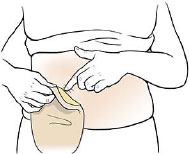Ileostomy
During an ileostomy, a surgeon removes the colon (large intestine) and part of the last section of the ileum (small intestine) if they are diseased. The surgeon may also disconnect parts of the intestine if they have been injured. Disconnection allows time for injured intestines to heal; then they are reconnected. In other cases, the ileostomy is permanent. During the ileostomy, the end of the ileum is brought through the abdominal wall. This makes an opening, called a stoma, for the contents of your intestines and mucus to pass out of the body. The following are general guidelines to follow after your ileostomy.
Colostomy
This is a life-saving procedure that involves removing or disconnecting part of your colon (large intestine). If your large intestine was diseased, your healthcare provider may have removed it. If it was injured, your healthcare provider may have disconnected it for a short time so that it can heal. After it heals, your healthcare provider may reconnect it. During a colostomy formation, your healthcare provider reroutes your colon through your abdominal wall. Stool and mucus can then pass out of your body through this opening, called a stoma. The following are general guidelines for home care following a colostomy. Your healthcare provider will go over any information that is specific to your condition.
Changing Your Ostomy Pouch

Your healthcare provider showed you how to change your pouch in the hospital soon after your surgery.
This sheet helps you remember the steps you need to follow to change your pouch. As a rule, a drainable pouch needs to be changed every 5 to 7 days. You will be emptying it more often.
Home care
- Gather the following supplies:
- Plastic bags
- Clean towel
- Toilet paper
- Extra skin protection
- Soft washcloth
- Scissors (if needed)
- New pouch
- Remove the used pouch:
- Sit on or next to the toilet.
- Empty the used pouch into the toilet if necessary.
- Starting at the upper edge of the skin barrier, carefully push the skin away from the barrier with one hand. Slowly peel back the skin barrier with the other hand.
- Peel all the way around the skin barrier until the pouch comes off.
- Seal the pouch in a plastic bag; then put it in a second plastic bag. Then Discard.
Cleaning Your Stoma Site

- Wipe any stool off the skin around the stoma with toilet paper.
- Clean the skin with warm water and a soft washcloth. Wash right up to the edge of the stoma. Pat the skin dry with a clean towel.
- If needed, put on extra skin protection, such as moisture barrier cream or powder
Preparing Your New Pouch

- Peel the backing off the skin barrier.
- Place the precut skin barrier over the stoma. If you don’t use a pouch with a precut skin barrier, size and cut the opening (1/16 inch bigger than the stoma) and peel the backing off the skin barrier. Carefully place it over the stoma.
- The pouch opening should point toward your feet.
- If using a pouch with a clamp at the base, it may be easier to apply the clamp to the pouch first.
- Snap the pouch onto the barrier flange (if you use a 2-piece pouch).
- Press the barrier against your skin. Hold it in place for 45 seconds.
- Clamp the tail of the pouch (if drainable or reusable).
When to call your healthcare provider
- Call your healthcare provider right away if you have any of the following:
- Pus, foul-smelling drainage, or excessive bleeding from your stoma
- A stoma that separates from the skin or looks like it’s getting longer
- A stoma that is recessing (pulling back) into the belly
- Bulging skin around your stoma
- Blood in your stool
- Change in the color of your stoma
- Fever of 100.4°F (38°C) or higher, or chills, or as advised by your healthcare provider
- Nausea or vomiting
- Increased pain in the belly or around the stoma
- No gas or stool made after 24 hours


